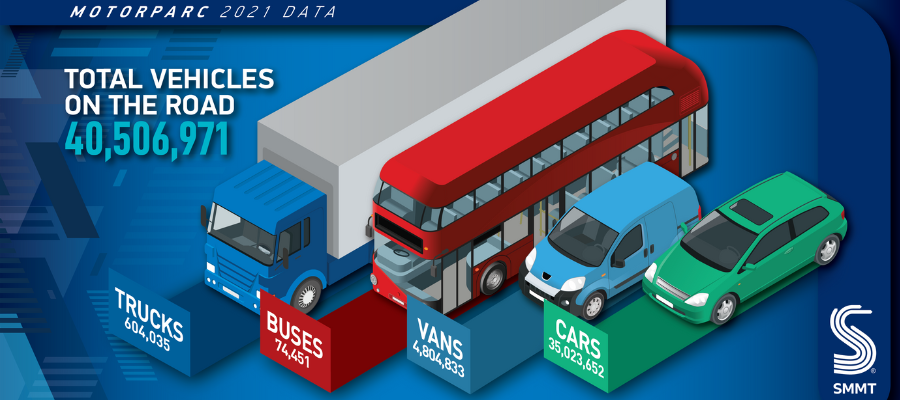🕒 Article read time: 2 minutes
Commercial vehicles now account for more than one in eight vehicles in service

The number of commercial vehicles on Britain’s roads has reached the highest level in history, according to the latest annual Motorparc data, published by the Society of Motor Manufacturers and Traders (SMMT).
Some 5,483,319 vans, trucks, buses and coaches were recorded in operation at the end of 2021, a 4.1% increase on the previous year.
NINE OUT OF TEN COMMERCIAL VEHICLES ARE VANS
Following a bumper year for registrations, vans account for almost 90% of this total, comprising 4,804,833 units, up 4.3% from 2020. The segment has enjoyed continuous growth since 2010 but fleet renewal has slowed. With the average van on UK roads now a record 8.7 years old, regional variations are significant. The youngest vans can be found in the North East, averaging 7.1 years old, while Wales is home to the oldest, with the average van dating back to 2011.
HGV NUMBERS RETURN TO GROWTH
HGV numbers returned to growth after last year’s fall, increasing 2.5% to 604,035. This was driven by significant growth in new registrations (up by 12.9%), but also retention of units already in service. However, the parc is still 0.7% down from its 2019 peak.
RISING UPTAKE OF ZERO EMISSION VEHICLES
Zero emission vehicle uptake is also increasing, although overall use remains at low levels. Some 26,990 plug-in vans are now in operation, equivalent to around one in 180, compared with around one in 50 in the car sector. With vans facing the same end of sale date for non-zero emission models in 2035, there is an urgent need for a ‘van plan’ of infrastructure and incentives to match the commitments already made by the automotive industry, commitments that have led to a plug-in option being available for a third of new models.
Truck electrification is also emerging, with 313 units in operation – less than 0.1% of the total fleet – with the recently announced government demonstration programme of zero-emission truck use having the potential to give operators greater confidence to invest in the latest technology. Currently, more than 98% of trucks are registered as running on diesel, although a proportion of these vehicles may be using alternative lower-emission drop-in fuels.
TRANSITION TO ELECTRIFICATION NEEDS A CLEAR STRATEGY
Mike Hawes, SMMT Chief Executive, said: “Commercial vehicles keep Britain’s economy on the move, and their growing proportion of the national fleet underscores their increasing importance. Nurturing the green shoots of the sector’s transition to electrification, however, will need a dedicated strategy. Every stakeholder will need to play their part, matching the commitments made by the automotive sector, which is investing to offer an increased choice of zero emission vans, trucks and buses to users even in the midst of global supply chain shortages.”
Michelle Gardner, Head of Public Policy, Logistics UK, said: “Following a dip in the number of HGVs in 2021, it is extremely encouraging to see the sector return to growth. The van sector, meanwhile, has proven that its surge in growth during the COVID-19 pandemic was not a blip but part of a long-term trend.
“While these vehicles are vital to moving goods the length and breadth of Britain, it is critical that they are renewed with the latest low and zero emission models if we are to achieve the next milestones in the journey to net zero.”
*www.logistics.org.uk/environment
Published On: 09/06/2022 16:00:56

Comments Section
If you are a Logistics UK member login to add comments.